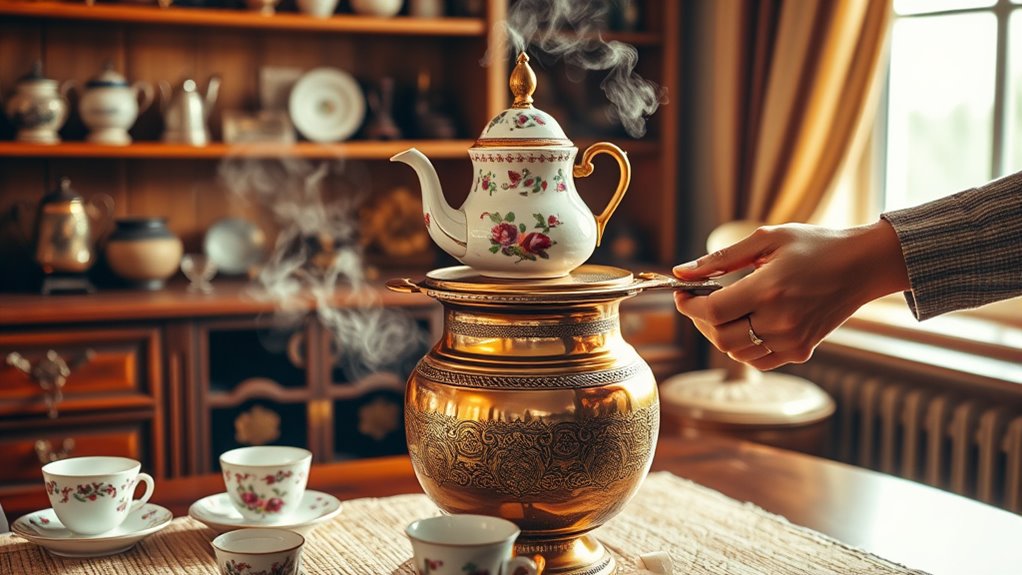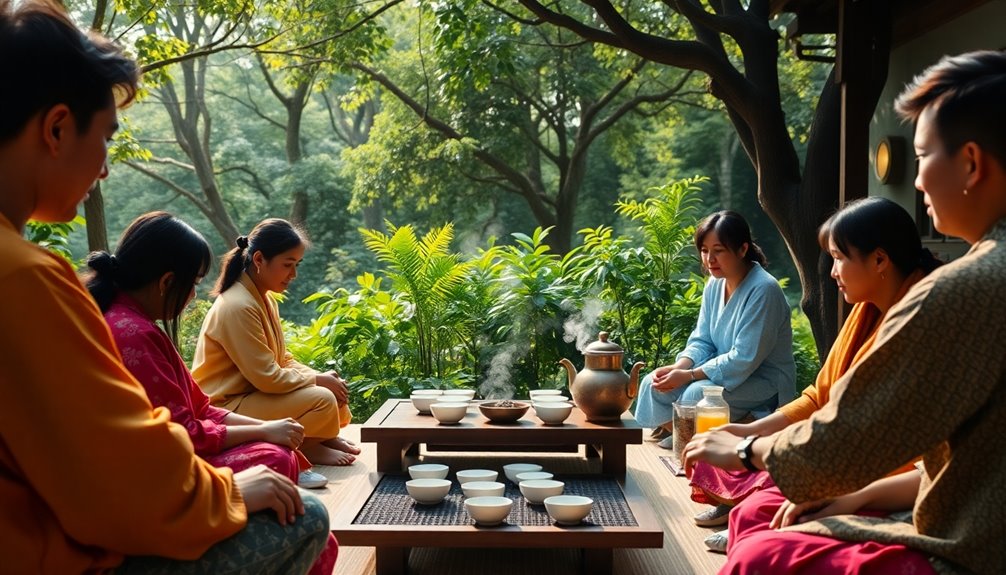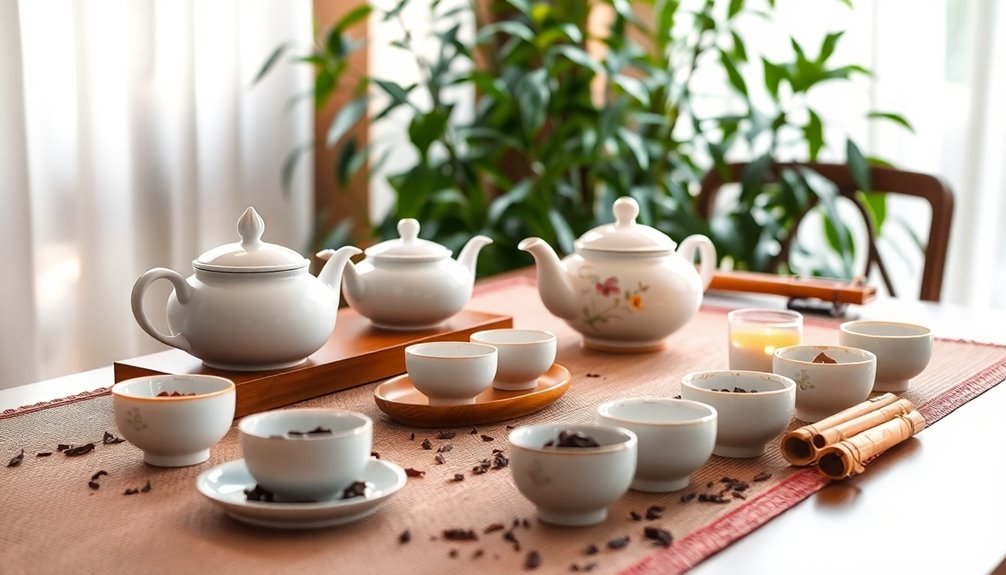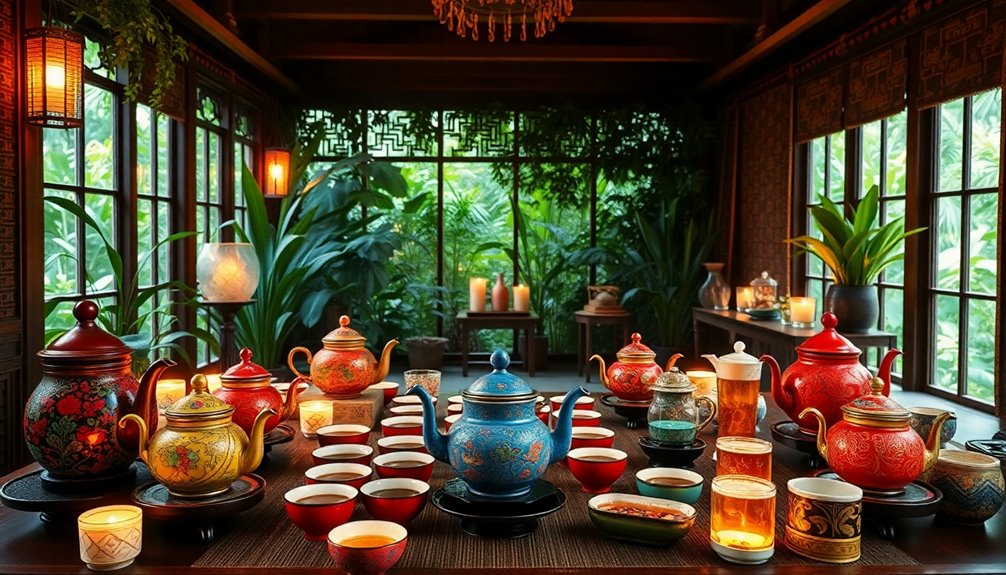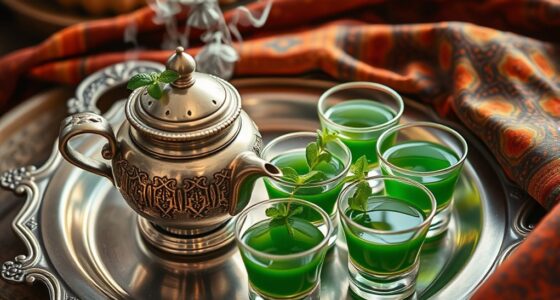To enjoy the samovar tea ceremony, start by filling the samovar’s boiler with water and heating it to a boil. Meanwhile, prepare a strong tea concentrate called a *zavarka*. Pour some of this into your cup, then add hot water from the samovar to taste. Careful serving and accompanying sweets set the mood for warmth and friendship. If you continue exploring, you’ll discover the deeper customs and cultural significance behind this cherished tradition.
Key Takeaways
- Fill the samovar’s boiler with water and heat until boiling.
- Prepare a strong tea concentrate in a separate teapot called a zavarka.
- Pour a small amount of the tea concentrate into a cup and dilute with hot water from the samovar.
- Serve the tea carefully into cups, often accompanied by sweets or lemon.
- Engage in social conversation, emphasizing warmth, hospitality, and shared tradition.

In Russia, the ceremony of preparing and sharing tea with a samovar is more than just a daily routine; it’s a cherished tradition that brings people together. This ritual embodies the essence of tea traditions and holds deep cultural significance. When you participate in this ceremony, you’re not just brewing a beverage—you’re engaging in a centuries-old practice that fosters warmth, hospitality, and connection. The samovar, a distinctive metal container, symbolizes Russian hospitality and is often the centerpiece of gatherings. Its presence signals an invitation to relax and share moments with friends and family, reinforcing bonds and preserving cultural heritage. The process begins with filling the samovar’s boiler with water, which is then heated to a rolling boil. As the water heats, you prepare a strong concentrate of tea, often in a separate teapot called a *zavarka*. The zavarka is essential because it allows you to customize the strength of your tea, a key aspect of Russian tea customs. You pour a small amount of this concentrated tea into your cup, then dilute it with hot water from the samovar to your preferred taste. This method ensures that each person can enjoy their tea just the way they like it, emphasizing the personalized nature of Russian tea traditions. Once the tea is prepared, the act of serving becomes a ritual in itself. You carefully pour the tea from the samovar into cups, often accompanied by a plate of sweets, biscuits, or bread. Sharing tea becomes a social act, where conversations flow effortlessly and everyone feels included. The warmth of the tea, combined with the warmth of companionship, makes the experience truly special. The host might offer a traditional sweet or a slice of lemon to enhance the flavor, adding to the sense of hospitality. The entire process is deliberate, highlighting respect, care, and the importance of community. Additionally, the timeless significance of the samovar underscores its role as a symbol of Russian life, embodying values of friendship and togetherness. By observing or participating in this ritual, you connect with a tradition that has endured generations. The shared experience of brewing and drinking tea with a samovar is a timeless act that captures the spirit of Russian hospitality. It’s a simple yet profound way to appreciate the country’s rich cultural tapestry, forging bonds that last long after the last drop of tea has been enjoyed.
Frequently Asked Questions
What Are the Origins of the Samovar Tradition in Russia?
You might find it fascinating that the samovar tradition in Russia has deep roots in tea culture and cultural symbolism. It originated in the 18th century as a symbol of hospitality and social bonding. Over time, the samovar became a central part of Russian life, representing warmth and community. Its design and use reflect the importance of tea in Russian customs, making it a cherished cultural icon across generations.
How Do Different Regions in Russia Vary Their Tea Ceremonies?
Regional rhythms reveal varied vignettes of Russia’s tea traditions. You’ll notice how local customs craft unique customs—some regions favor fiery, flavorful samovars, while others prefer subtle, soothing sips. From Siberia’s hearty hospitality to the Caucasus’ colorful celebrations, each area adds its own authentic flavor. You can explore how diverse regions define their distinct, delightful tea rituals, blending boldness with tradition, and creating a cultural mosaic of memorable moments around every steaming cup.
What Are Common Accompanying Foods Served During the Samovar Tea Ceremony?
During the samovar tea ceremony, you’ll often enjoy snacks pairing that enhance the flavors. Common accompaniments include regional delicacies like sweet pastries, honey, and jams, which complement the tea’s warmth. You might also find savory options like bread with butter, cheese, or cured meats. These foods create a delightful contrast, enriching your experience and highlighting the diverse regional tastes across Russia.
How Has Modern Technology Influenced Traditional Samovar Practices?
You’ve probably noticed that digital brewing and online tea culture are transforming traditional samovar practices. You now explore new flavors through online platforms, share your tea moments on social media, and even use digital devices to control brewing temperature. These innovations blend modern convenience with tradition, making the samovar experience more accessible and interactive. As you embrace technology, you keep the rich history alive while connecting with a global community of tea enthusiasts.
Are There Specific Etiquette Rules for Hosting a Samovar Tea Gathering?
When hosting a samovar tea gathering, you should follow traditional tea etiquette to guarantee guest hospitality. Offer tea with respect, serve everyone equally, and keep the atmosphere warm and welcoming. Be attentive to your guests’ needs, refill their cups promptly, and engage in friendly conversation. Remember, good manners and genuine hospitality create a memorable experience, honoring the cultural significance of the samovar while making your guests feel comfortable and appreciated.
Conclusion
Now that you know the steps, you’re ready to relish the rich ritual of samovar tea. Embrace the elegance, enjoy the experience, and immerse yourself in Russia’s revered tradition. With each sip, savor the slow, soulful ceremony that connects history, hospitality, and heart. So, step into this special sphere, and let the timeless tingle of tea transport you through tradition and time, turning a simple sip into a soulful ceremony.

